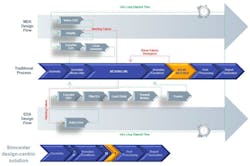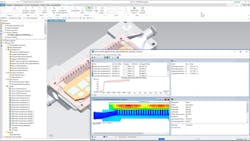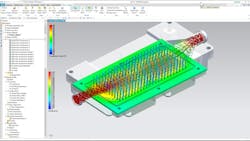Siemens extended its Simcenter software to focus on design-centric thermal simulation of autonomous electric vehicles (AEVs). The end-to-end design solution is integrated with CAD systems to address all aspects of AEV design including battery-pack design and powertrain electronics (Fig. 1).
1. Thermal design impacts all stages and aspects of system design in autonomous vehicles.
The software even deals with cabin design, where HVAC and sensors come into play. This is critical in terms of power utilization, because electric vehicles need to share resources to keep occupants comfortable as well as move them to their destination. For example, summer conditions in Arizona will require power for air conditioning, which can be simulated using the tools. Thus, developers can do effective cabin design as well as look at how it relates to other power and thermal aspects of the overall system.
“Strategy Analytics expects that the vast majority of self-driving cars will feature electrified powertrains,” says Ian Riches, executive director, Automotive Practice for Strategy Analytics. “The OEMs who distinguish their vehicles with trusted AD performance, long drive range per charge, and optimal in-cabin experiences are likely to be the winners in this new era of mobility. Thermal design software such as Siemens’ new Simcenter solution is ideally suited to help OEMs and suppliers differentiate and win in the competitive AEV markets of the future.”
2. Siemens looks to significantly reduce the time needed to generate a good thermally designed system.
Siemens is looking to significantly reduce the amount of time and effort needed to deliver a good, thermally efficient design (Fig. 2). It does this by trimming down the iterative aspects that a developer must employ to test thermal-design considerations. Integration with CAD tools allows the system to extract the necessary information for a thermal simulation and perform that simulation quickly.
FloEFD is one of the main components of the system. FloEFD is accessible from CAD tools like Siemens NX so that developers don’t have to leave their design environment (Fig. 3). It also brings information-rich computational-fluid-dynamics (CFD) technology to mainstream automotive engineers, enabling the generation of highly accurate thermal digital twin simulations. The system works with most major CAD tools as well.
3. FloEFD is accessible from CAD tools like Siemens NX so that developers needn’t to leave their design environment.
FloEFD delivers graphical and tabular results within the CAD tools; thus, developers are able to easily visualize thermal-simulation results (Fig. 4). The system also provides capabilities like co-simulation of component thermal and electric powertrain performance, connectivity between simulation of electric motor performance and system simulation for electrical and thermal management, and design space exploration using the thermal digital twin models.
4. Because FloEFD provides graphical and tabular results within the CAD tools, developers can easily visualize thermal-simulation results.
The overall solution for design-centric thermal simulation has three main components: Simcenter FLOEFD software for electronics and electric powertrain thermal simulation within native CAD environments; Simcenter Motorsolve software for electric motor design; and component design to 1D system thermal-design co-simulation with 1D CFD Simcenter Flomaster software.






